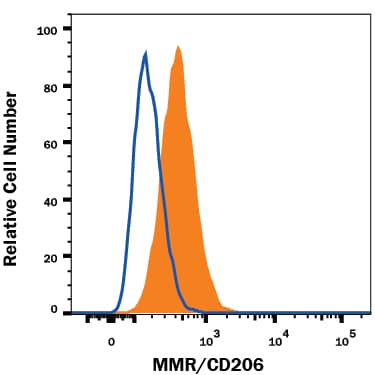Mouse MMR/CD206 Antibody
R&D Systems, part of Bio-Techne | Catalog # MAB25351


Conjugate
Catalog #
Key Product Details
Species Reactivity
Mouse
Applications
CyTOF-ready, Flow Cytometry
Label
Unconjugated
Antibody Source
Monoclonal Rat IgG1 Clone # 857615
Product Specifications
Immunogen
Mouse myeloma cell line NS0-derived recombinant mouse MMR
Leu19-Ala1388
Accession # Q61830
Leu19-Ala1388
Accession # Q61830
Specificity
Detects mouse MMR in direct ELISAs.
Clonality
Monoclonal
Host
Rat
Isotype
IgG1
Scientific Data Images for Mouse MMR/CD206 Antibody
Detection of MMR/CD206 in J774A.1 Mouse Cell Line by Flow Cytometry.
J774A.1 mouse reticulum cell sarcoma macrophage cell line was stained with Rat Anti-Mouse MMR/CD206 Monoclonal Antibody (Catalog # MAB25351, filled histogram) or isotype control antibody (Catalog # MAB005, open histogram), followed by Phycoerythrin-conjugated Anti-Rat IgG Secondary Antibody (Catalog # F0105B).Applications for Mouse MMR/CD206 Antibody
Application
Recommended Usage
CyTOF-ready
Ready to be labeled using established conjugation methods. No BSA or other carrier proteins that could interfere with conjugation.
Flow Cytometry
0.25 µg/106 cells
Sample: J774A.1 mouse reticulum cell sarcoma macrophage cell line
Sample: J774A.1 mouse reticulum cell sarcoma macrophage cell line
Formulation, Preparation, and Storage
Purification
Protein A or G purified from hybridoma culture supernatant
Reconstitution
Reconstitute at 0.5 mg/mL in sterile PBS. For liquid material, refer to CoA for concentration.
Formulation
Lyophilized from a 0.2 μm filtered solution in PBS with Trehalose. *Small pack size (SP) is supplied either lyophilized or as a 0.2 µm filtered solution in PBS.
Shipping
Lyophilized product is shipped at ambient temperature. Liquid small pack size (-SP) is shipped with polar packs. Upon receipt, store immediately at the temperature recommended below.
Stability & Storage
Use a manual defrost freezer and avoid repeated freeze-thaw cycles.
- 12 months from date of receipt, -20 to -70 °C as supplied.
- 1 month, 2 to 8 °C under sterile conditions after reconstitution.
- 6 months, -20 to -70 °C under sterile conditions after reconstitution.
Background: MMR/CD206
References
- Gazi, U. and L. Martinez-Pomares (2009) Immunobiology 214:554.
- Martinez-Pomares, L. (2012) J. Leukoc. Biol. 92:1177.
- Harris, N. et al. (1992) Blood 80:2363.
- Taylor, M.E. et al. (1990) J. Biol. Chem. 265:12156.
- Chieppa, M. et al. (2003) J. Immunol. 171:4552.
- Figdor, C. et al. (2002) Nat. Rev. Immunol. 2:77.
- Taylor, P.R. et al. (2005) Trends Immunol. 26:104.
- Allavena, P. et al. (2010) Clin. Dev. Immunol. 2010:547179.
- Leteux, C. et al. (2000) J. Exp. Med. 191:1117.
- Martinez-Pomares, L. et al. (2006) Eur. J. Immunol. 36:1074.
- Taylor, M.E. et al. (1992) J. Biol. Chem. 267:1719.
- Singh S.K. et al. (2011) Eur. J. Immunol. 41:916.
Long Name
Macrophage Mannose Receptor
Alternate Names
CD206, CLEC13D, MRC1
Gene Symbol
MRC1
UniProt
Additional MMR/CD206 Products
Product Documents for Mouse MMR/CD206 Antibody
Product Specific Notices for Mouse MMR/CD206 Antibody
For research use only
